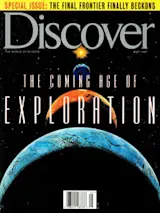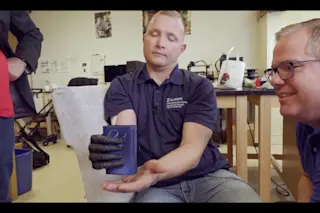Richard Zare doesn’t want to talk about life on Mars. It’s not that the prospect of life on other planets isn’t fascinating. It’s just that everything else is, too. The Stanford chemistry professor sits behind the enormous conference table that extends from his desk, an acre of oak sown here and there with lecture notes, correspondence, manuscripts, congressional testimony, and results of experiments in progress. A lot of it is Mars-related--which is great, what’s not to like?--but Zare was busy and happy enough before there were people asking for his autograph, farmers calling him to ask if the red rocks they’d plowed up were Martian, and everyone in the media asking for just a minute with the man who told Jim Lehrer we may all be Martians: Ted Koppel, Time, the documentary director who demanded he be filmed while bathed in an eerie red glow (Zare refused), and now you, waiting by the door while he checks his E-mail.
When he’s finished he hops out from behind the desk and greets you like an old friend. Zare has a class to teach in a few minutes, so he is dressed up in a jacket and tie, which you can’t help noticing because it displays the periodic table of the elements running vertically down toward a silver belt buckle, a big square western number. An artless smile lights up his broad face, as if he is half-expecting something enjoyable to happen, if not this moment, then maybe the next. You remember this luminous beam of a face from the now-famous press conference at NASA headquarters when the discovery was announced, one face among several at the podium because coaxing evidence for ancient life out of a Martian meteorite is the work of many very bright minds. But only one face up there was still smiling through the jet lag and the glare of the television lights, the big elfish one with the thick square-rimmed glasses and salt-and-pepper goatee. Mars, of course, is what you have come here to ask about, but before you can get your notebook clear of your pocket, Zare is asking you a question, catching you off guard.
What do you think of this? he asks, pointing to a large and very agitated object on the coffee table. Something retro-existential, a human figure composed of ball bearings, hex nuts, and threaded pipe, a face like a metal pizza. It is holding two candlesticks aloft in case anybody wants to have a quiet romantic dinner. The first response that comes to mind is Yard sale? and while you are rummaging for a more tactful reply, Zare himself admits that the sculpture is here in his office because his wife refused to have it in the house.
I think it’s ugly and powerful. She just thinks it’s ugly. He laughs. Then he tells you how he came across the figure recently in Berlin, in an abandoned department store that was burned out in World War II and now held in hostile occupation against the police by a coalition of drug dealers, prostitutes, and artists. It is a good story, and the voice telling it is high and impetuous, leaping from one syllable to the next like somebody with his pant cuffs rolled up jumping rock to rock through a stream. By the end you are appreciating the sculpture, but Zare has barely enough time to make it to class. He heads for the lecture hall at a trot, not like a professor who is late, but like a boy hurrying toward the swimming hole on a clear summer morning.
There’s nothing better than teaching freshman chemistry, he says on the way. It’s the researcher’s secret weapon. These kids really make you think.
You follow along and realize that you now feel rather cheerful yourself for a Monday morning. And not a word so far about life on Mars.
When he was very young, Dick Zare found some chemistry books lying around the house. They belonged to his father, whose own hopes of becoming a chemist had gone sour and died in the Depression. Working a series of jobs ranging from ice cream vendor to rug cleaner, he would tell his son to leave the books alone: they would only lead to unhappiness. Zare took them to bed and read under the covers by flashlight. Forbidden literature.
His father’s prediction was off by 180 degrees. The happy times were with the books. Dealing with people, especially with the father, was harder. Dick was the kind of child who wouldn’t hold hands for ring-around- the-rosy, who came close to flunking kindergarten because he couldn’t tie his shoes. His father had tried to teach him, which was so traumatic an experience that he never wanted to learn. At age five he was put in therapy, but it didn’t help. In third grade things got worse. His family moved from Cleveland Heights, which was almost all Jewish, to Lyndhurst, where the Zares were the only Jews. Come Christmas, Zare’s teacher asked why he wasn’t singing the carols with the other children, and he replied that he didn’t know the words, and even if he did he wouldn’t sing them because they were false. He got beat up by the other kids and was called Christ-killer.
Am I giving you a sense of things? he asks, the smile pained now but still artless. It was a disaster. He doesn’t mean just getting beat up. He means the whole thing. Childhood.
But there was a way out, a way to feel good. At the age of eight Zare discovered a place where the bedcovers arched over a hundred thousand forbidden books and the flashlights never dimmed. At the Cleveland Public Library he could escape for hours, reading and playing chess. (He still plays. Several games at once. Blindfolded.) In junior high he was a lone wolf, lugging science books to school, knowledgeable enough by then to know how little was known. This led to disruptive disputes with his science teacher, who thought that if he admitted he didn’t know something he would lose control of the class. It finally got too much for the poor teacher, who told Zare’s parents point-blank that he hated the kid’s guts. The principal decided it would be best if Dick left the school.
Somehow he got a scholarship to the nearby private University School for Boys--filling their Jewish quota, Zare suspects. However he ended up there, it turned out well. His talent was noticed and nurtured, especially by an English teacher named Chilton Thomson. By his senior year Zare had built a primitive computer out of war surplus relays. When he won a full scholarship to Harvard, Thomson took him to his private tailor and had him fitted--suits, shoes, shirts, ties, all the proper attire for when Thomson himself had gone to college.
I looked at all this stuff and asked him how I could ever repay him, Zare remembers. He said to me, ‘To be honest, you can’t. But someday, you can help someone else.’ I’ve always cherished those words.
Zare’s is a morning class, so the students enter the lecture hall in a comatose state. Those conscious enough to form sentences chatter quietly in pairs or trios, while the rest, splayed legs with backpacks attached, wait for the caffeine and circadian clocks to kick-start brain function. There will be plenty before the hour is through. The course is called The Frontiers of Chemical Science, taught by Zare and chemist James Collman, and it lives up to its title: rather than sticking to textbooks, it flings the students right out to the edge, with a little spirited guidance to keep them from falling off. The class has a reputation as the hardest course at Stanford, but students have voted it one of the top courses on campus.
Today’s lecture is part two of a primer in chemical analysis. In the previous class, Zare had introduced the students to mass spectrometry, a technique for identifying an unknown compound by the pattern of ions into which it fragments when hit with an electric charge. With an overhead projector, Zare shines two columns of numbers on a screen: the atomic weights (representing the number of protons and neutrons) of the ion fragments and the abundance of each. The challenge for the class is to use this information to unmask the hidden identity of the exploded molecule. (The challenge for you, absent from chemistry class for 30 years, is not to abandon hope.) The columns show that the greatest number of ions have atomic weights of 96, and the next greatest have 61. Zare picks up a piece of chalk and writes on the blackboard:
96
-61
35
So far, you are with him. He stands back for a moment and looks appreciatively at the numbers, as if a problem even this simple has something wonderful inside it--an energy, a possibility.
Thirty-five, he says, cheerily, as if it was an unusually good- natured number. That gives me a clue.
The clue is that the dominant isotope of the element chlorine has an atomic weight of 35. Ninety-six is the atomic weight of the total parent molecule, so 61 must be the parent molecule with a chlorine atom removed. But while this reveals that chlorine is an ingredient of the compound, there is a problem: chlorine, Zare points out, comes in two flavors--plain old vanilla chlorine 35 and the less common chlorine 37. The difference between them is two extra neutrons in the nucleus, which changes its weight. So we use this new clue to decode the pattern of fragments further.
Zare passes out a crib sheet, does some math on the board, working out the coefficients of the binomial expansion, which you remember vaguely as a hoary, monstrous unintelligibility that now, beyond belief, is making sense. He fills up the blackboard with more complex calculations, entering more treacherous territory, but ever so patiently, as if he is not so much teaching as discovering it anew himself. Zare pauses every now and then to witness the evolving solution the way a sculptor might regard a figure emerging out of stone. Intentionally or not, these pauses give the students a chance to catch up and see it too. By this point you are lost, but they are moving toward it, buzzing, 18- and 19-year-olds with their angst suspended for an hour, screwed to the heart of the matter. Then Zare is talking about Einstein and E= mc2, and somehow it all ends with something quite amazing, a wild idea I want to tell you about, he says to the students: that it would be possible to calculate the energy of molecules by their molecular weights.
No one’s ever done this, by the way, he tosses out, like a seed into plowed earth. So go do it.
Outside Zare’s office door there is a poster announcing a series of lectures he delivered recently at a university in Germany. As you wait for him to finish talking to a graduate student, your eye wanders down the lecture topics on the poster. Each represents some trajectory of his ongoing work. Most are phrased in unfamiliar terminology: Single Molecule Detection in Solution Using Confocal Fluorescence Microscopy and Visualizing the Transition-State Region in a Bimolecular Reaction. Zare finishes, senses your bafflement, and comes over to help. One by one he reduces each to its essence.
That first lecture was about a technique we’ve developed for seeing individual molecules, he says. That’s the ultimate limit of analytical chemistry. You can’t see anything less. The second one is also about witnessing the unwitnessable, in this case the intimate act of breaking old bonds and making new bonds in a chemical reaction. He skips over title number three, Laboratory Measurements of Extraterrestrial Visitors, then explains number four, which involves a new technique for detecting genetic defects. Still others propose ways to quantify trace chemicals in the atmosphere, or measure electric signals on unimaginably tiny time scales, or investigate the biochemistry of memory. Zare’s research bears a lot of qualities that appeal to funding agencies. A single-minded focus isn’t one of them.
He’s like a little kid, says Stephen Pentoney, a former Zare postdoc now with Beckman Instruments, which has licensed several of the 50- odd patents spat out by Zare’s laboratory. He’ll get involved in everything.
To Zare himself, however, the everything is the whole point. Do you know how Alfred North Whitehead defined Unitarianism? he asks. It’s the belief that there is at most one god. Well, I believe there is at most one science. I’m not interested in divisions. They only get in the way of doing creative science.
The Zarelab is in fact a sort of three-floor furnace of creative science, or rather a collective of separate ovens, because the fires burn bright behind each door. The 30 or so postdocs and grad students help each other out, but each forges his or her own creation. There are a dozen separate projects going on here, and every one is new and exotic, every one is cutting edge, says postdoc Russell Low. Together with Hao Xu, Low spends his days and nights watching the simplest possible chemical event: what happens when an atom of hydrogen collides with a molecule composed of two other hydrogen atoms? The free atom breaks the molecule apart and replaces one of the formerly bonded ones, which goes caterwauling off through nanospace. This most fundamental of all chemical reactions has occupied theoretical and experimental chemists for more than 60 years, but it is still not fully understood. Thanks to a detection technique developed by Zare, Low, and Xu, it may soon be.
Next door, grad student Daniel Chiu lives behind a black curtain in a city of lasers, mirrors, and microscopes. The instrumentation took him a year to set up, but the payoff has been well worth it: a device that enables him to visualize and videotape a single molecule in a room- temperature solution. How does a protein fold? Someday you’ll be able to just watch the screen. How does a molecule of DNA evolve over time? Roll the tape again and look for yourself.
The Zarelab is crammed with students like Chiu and Low, and while none of these people would be here if they didn’t have the talent and desire, Zare is the person who holds it together, seven days a week--at least when he’s not testifying before Congress, flying off to collect meteorites in the Antarctic, or serving as chairman of the National Science Board. That position gives him a tremendous opportunity to help shape national science policy, and he relishes the prospect. But nothing comes before his people.
Me? I’m just a big cheerleader, Zare laughs. Only this cheerleader reserves the right to boo. Then he adds, If there is a theme to all this, it’s that we tend to use lasers.
Only later do you realize he is trumping one understatement with a bigger one. Dick’s contribution to science has been to show chemists what a fabulous tool a laser can be, says Dudley Herschbach, Zare’s thesis adviser at Harvard and a 1986 Nobel laureate in chemistry. He’s applied it to an enormous range of problems, particularly those concerning what molecules actually do in intimate interactions with each other. He’s moved us to a completely new level.
In his junior year in college, Zare began to wonder about how we see: not about the biological mechanisms of visual perception, but about the very nature of light and how it interacts with matter to produce the patterns that can be perceived in the first place. Seeing, he had been taught, is believing; but if he couldn’t understand how we see, how could he believe in anything? What started as a fascination with light turned into a soul-searching crisis. For a time Zare seriously considered dropping out of school. Luckily he found some stoic wisdom to go along with his brilliance. For example: Light has both wavelike properties and particlelike properties. It’s frustrating. But you learn to live with it.
He was able to do a groundbreaking thesis in 1964 on the photodissociation of molecules, how pulses of light could kiss a molecule and knock it apart in such a brief flicker of time that as the fragments fly apart they can offer a clue to the shape of that molecule, how it is poised in space. His work was entirely theoretical, but when he got his hands on the newly invented laser, he found that he could use it to charm molecules, make them giggle and dance and expose themselves even as they collide with other molecules in those intimate interactions that are chemistry, which is life.
One of Zare’s many tricks with light, and the one probably most appreciated by his colleagues, involves a process called laser-induced fluorescence, in which a laser beam, shining on a molecule, persuades that molecule to make a tiny colorful commotion that illuminates its identity. The molecule absorbs laser light of one color and is excited to a higher energy level. As it tumbles back to its ground state it throws off other colors, and the pattern serves as a fingerprint for the molecule. Combine laser-induced fluorescence with other means of molecular detection--for instance, capillary electrophoresis (whose development was also pioneered by Zare, thank you)--and you have a fantastically sensitive probe not just for identifying molecules but for revealing what energetic state they happen to be in at any specific nano-moment.
Next to that invention, detecting chemical traces of what might be life on a meteorite from Mars can seem like child’s play. But you begin to appreciate that all of Zare’s work is in a sense child’s play. I’m an opportunist, says Zare. If I see a problem that I don’t know, I want to solve it. So there are always a lot of projects going on. Mars was just one of them. But then it blew up.
It started one quiet night several years ago, when Zare encountered a stranger on the campus who told him meteorites contained messages from outer space.
That got me interested, says Zare. I told him I thought I had a machine that could help interpret those messages.
The stranger was Peter Buseck of Arizona State University, who spent a sabbatical at Stanford. The machine was another Zarelab construction with a laser for a heart, or in this case, two lasers--the Microprobe Two-Step Laser Mass Spectrometer. Its design is surprisingly simple. Step one: A sample of organic matter is placed in a vacuum chamber that contains an electric field, and a laser pulse of infrared light is focused on a small target area, about the size of a period. The pulse lasts for only a few millionths of a second, but its intensity is enough to heat up the target at a prodigious rate, more than 100 million degrees per second. This quick blast of radiation raises a vapor puff of intact, undamaged molecules from the surface.
In step two, this rising vapor plume is assaulted by a second laser, an ultraviolet pulse 60 times brighter than the first one but lasting only a few billionths of a second. This unimaginably fleeting burst of energy knocks an electron off the neutrally charged molecules, leaving them with a positive charge. What follows is a miniature horse race. With their positive charge, the molecules gallop out of the vapor cloud toward a negatively charged detecting plate about five feet away. On average, they take about 65 microseconds to travel the distance. But since different molecules have different weights, some gallop faster than others: the smaller the molecule, the quicker it reaches the detector. A molecule’s time of flight serves as a measure of its mass, which can then be used to determine its identity.
Zare and his students started training his laser mass spectrometer on meteorite samples just to see what was there. Soon he and grad student Simon Clemett were going after larger game, which in this case meant smaller particles: clusters of interplanetary dust collected by U-2 spy planes penetrating the stratosphere. Then, about three years ago, one of his many collaborators put Zare in touch with David McKay and Everett Gibson at the NASA Johnson Space Center. They told him they had some intriguing meteorite material and asked if he would do them a favor and analyze the stuff. A little while later Clemett got three pieces of rock in the mail from nasa. They were identified only by the code names Mickey, Minnie, and Goofy.
I had my suspicions, but we really didn’t know what they were, Clemett says. I ran some preliminary tests on them, and the people at jsc got all excited. They asked him and Zare to do more tests, but the chemists wanted to know what the fuss was about. That’s when they told us the meteor was Martian and they were looking for signs of life.
What Zare’s lab had found were traces of polycyclic aromatic hydrocarbons, or pahs for short. These organic compounds frequently result from the decay of microorganisms. But Zare was skeptical that Martian microbes were at work, since pahs can also be produced by wholly inorganic means, and indeed have been found many times before in extraterrestrial materials. Yet the NASA scientists had meanwhile found other possible evidence of ancient life in the meteorite--minerals, perhaps produced by bacteria, and images, conceivably of the fossilized bacteria themselves. Still Zare held out. Then he and Clemett found that the pahs and these other traces were not scattered randomly in the rock but were clumped together in globules of carbonate. So they, too, got excited. Even then, Clemett had months of painfully tedious work ahead to verify that the pahs he and Zare were finding were clearly coming from the Martian rocks. We finally believed there was a case to be made, Zare says.
The nasa-Stanford researchers decided it was time to publish their results. Then came the explosion. The press conference and publicity; the E-mail mailbox overloaded with congratulatory messages; the ufo abductees calling in and tying up the phone until Zare’s resourceful assistant found a support group to refer them to; and all the rest of the bluster that Zare calls Mars madness. And almost immediately they were hit by a backlash of criticism. The evidence was thin, shouted the naysayers, or too circumstantial, or equivocal, or the whole thing was cooked up by NASA to stay the poised axes of a stingy Congress. Most of the beefing was not only inevitable but wholly appropriate. As the late Carl Sagan commented, extraordinary claims require extraordinary evidence, and this was certainly an extraordinary claim.
If we are proved right, Zare says simply, it means that life is not unique to Earth. If Mars could support life in its early history, then it probably evolved on countless other planets too. So all of a sudden the universe is a much more exciting and wondrous place.
Zare is the first to admit, however, that stronger evidence is needed before life on Mars is anything more than a hypothesis. Since the original announcement, he and Clemett have started to look for amino acids in the meteorites. If these building blocks of proteins are found associated with the pahs, it will further bolster the case.
Zare and Clemett are also eager to continue the more difficult analysis of interplanetary dust. The problem is one of sheer size, or lack of it. In the work with the Martian meteorite, the two-step laser device homed in on rock samples weighing two or three milligrams. These are boulders compared with the space dust particles, which weigh less than a hundred-millionth of a gram.
No one has ever analyzed anything this small, says Clemett. So whatever you find is a surprise.
A surprise, or perhaps an opportunity. Judging from the isotopic profiles of the carbon they contain, molecules in these particles may represent the primordial interstellar material out of which our solar system condensed. This cosmic shmutz, as Zare calls it, may be older, and come from farther away, than anything else ever studied in a laboratory. That makes it a very precious opportunity indeed. A few billion years ago Earth was just another sterile ball, with all its carbon used up in the form of carbon dioxide. Then somehow this planet--and Mars, too, perhaps-- got the carbon needed to make something happen: life. Quite possibly, much of the carbon was brought in on interplanetary dust particles such as the ones whose molecules are now under study. Which leads Zare to a question that seems just about the right size and fit for him.
What is life, really? he asks. I thought I knew the answer when I was a boy and people would take me to the zoo. Life was animals running and flying around, or plants consuming oxygen. Now we’re finding that it is a lot more about bacteria than anything else. We’re discovering bacteria living on hydrogen, belching methane, living in sulfur, living everywhere--and zoos don’t show that. Life turns out to be a lot hardier than we thought. I’d like to learn more about it.
You get the feeling he will. And he’ll have a good time doing it.














